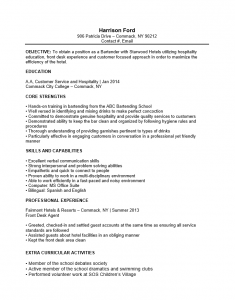
|
Bartender (No Experience Entry Level) Resume Template |
The Bartender (No Experience Entry-level) Resume Template delivers a functional chronological resume format. This tends to be the winning choice when a job hunter has little to no experience in a field. The race for a bartender position is often a quick one and is won only by candidates who can balance (and prove) their skills with an excellent looking resume. The Bartender (No Experience Entry-Level) Resume Template provides the structure for delivering such a document relatively quickly once the sections have been filled out correctly.
Each heading is a standard section that hiring entities will need to see on a resume. The user will need to fill out the content under each heading and once this content has been set and proofread, the resume is ready to go. In addition, this resume template can easily be revised specifically to a potential employer’s needs since formatting issues and static content (i.e. your name) will not need to be issues. This frees one from time consuming tasks that would otherwise detract a user’s focus from creating high quality content each time they apply for a desired position. The Bartender (No Experience Entry Level) Resume thus allows its users to enjoy the benefit of delivering a crisp resume in a relatively short amount of time.
How to Write.
Step 1. The top of the page should be where your name and contact information are placed. It’s generally suggested to make your name stand out by enlarging the font or bolding it. Needless to say the contact information must be up to date since this is how the potential employer will contact you.
Step 2. The Objective section is usually a brief one. Here, compose a few statements regarding your intention of attaining this position and how your skills will benefit the employer if they hire you.
Step 3. The Education section is reserved for your academic credentials. It should include any degrees/certificates you have, the year you earned the, the name of the appropriate school as well as the city and state of that school.
Step 4. The Core Strengths section will directly relate to your abilities. What are you particularly good at? Have you excelled at any particular task that an employer would consider of value. State your proficiencies, knowledge, and any training you may have.
Step 5. The Skills and Capabilities section will expand the Core Strengths section by directly relating to both you and the employer. This is a specific section. You must answer the requirements listed in the job posting you are inquiring about so long as they relate to you. If you do not have experience with all the requirements listed don’t worry. Just focus on the ones that apply to you.
Step 6. The Professional Experience section is basically your job history. State the company name of your previous employment, its city and state, and the date range you worked for them on the first line. The next line is only for the job title assigned to you and the next few lines are a brief synopsis of your duties and accomplishments relating to that title.
Step 7. The Extracurricular Activities section will show your personal interests and how you spend your time. This can be an important section since it provides an opportunity both for networking with a potential employer who has similar interests or showing that you are involved in a network that may in the future prove handy for building a client base in your new job.


